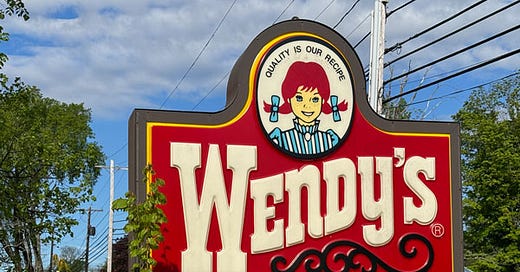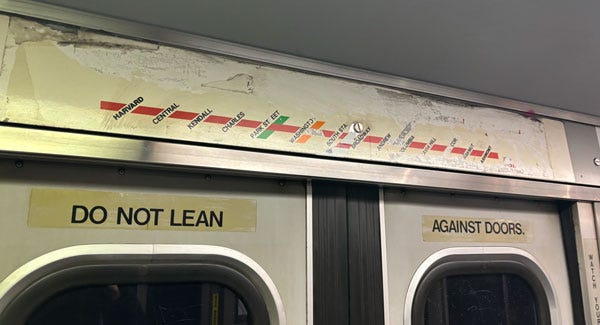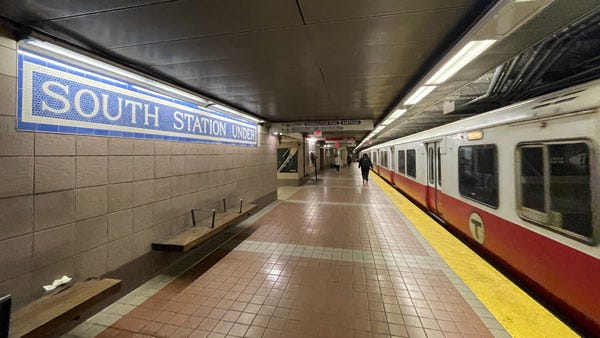Wednesday Walk: Voices in the Fight
How a Wendy's sign has me thinking about Palestine, unknowingly riding vintage trains, and busy with a move
Welcome to Willoughby Hills!
Every Wednesday, I offer a few short ideas that I hope will inspire you to do some more reading, thinking, and exploring. Let’s take a little walk together and see where the path leads…
Both Ends
As of yesterday, we have one month left in our old house. I know I first told you about purchasing a new home back in February, so the process of buying a new house, packing up our old one, selling it, and finally handing over the keys has probably felt long and drawn out.
For me, there have been very hectic periods and relatively quiet ones. We are definitely in a hectic period now, which is part of why I didn’t have a newsletter on Sunday this week. We’ve been working hard to unpack, renovate the kitchen, and do about 100 small tasks while still mostly living away from our new house until the school year ends.
The next few weeks may be quieter for me because of all this work, but hopefully after that, things will settle back into a routine again. Thank you for your patience as I work through the chaos.
Shifting the Window
Depending on which social media platforms you use and how your algorithm is tweaked, you may or may not know that the next phase of activism in the Palestinian liberation movement is to try to shame celebrities and influencers into speaking out against the genocide and to block those who don’t.
There are some big stars who have been vocal over the last few months: Jenna Ortega, Melissa Barrera, and Pedro Pascal to name a few. But those who have yet to make a public statement against the murder of Palestinians are being blocked en masse, an attempt to limit reach and revenue.
It’s important in this moment, and indeed during any period of social change, for all members of society to use their voice to stand on the right side of history. Celebrities and others with millions of followers have an even greater obligation to do this.
But does speaking out really matter?
I ran across a recent example that to me shows that it does. Earlier this week, I drove by this sign at the Wendy’s in Maynard, MA:
On its face, this sign may seem fairly standard, but I see it as an important part of the story of workers’ rights in the U.S.
Back in November, 2012, some 200 fast food workers in Manhattan, led by Black workers and other workers of color, organized a mass walkout. Their demand at the time felt extreme, maybe even unachievable: a starting salary of $15 an hour for fast food workers. Even if that might have been a livable wage in Manhattan, it seemed impossible to think that workers everywhere might be able to demand such a high salary, especially in an industry like fast food.
But over the last decade, we’ve seen the “Fight for $15” became a national rallying cry. It was a digestible, alliterative slogan that quickly caught on and it shifted the political window on this issue from impossible to possible to happening.
While the federal minimum wage still sits at $7.25 today, the Fight for $15 movement did help bring change in big ways. According to the Bureau of Labor Statistics, the national average fast food worker wage is now $14.48. In Massachusetts as of 2023, minimum wage is now $15 an hour. This Wendy’s in suburban Boston is exceeding that, offering $16.50.
The current Free Palestine movement is a direct descendant of not only Fight for $15, but also Black Lives Matter, Occupy Wall Street, and other groups that have fought for radical changes to our system.
Had workers sat quietly and simply accepted a low wage, companies would gladly continue to pay next to nothing.
Yet a handful of workers in New York more than a decade ago set off a national movement which has resulted in better working conditions for everybody, including in the small town of Maynard at a random Wendy’s on Powder Mill Road.
It takes every voice, large and small, to speak out for change to really happen. How are you using your voice right now?
Public Transit Back Stories
I’ve been riding the Red Line in Boston so much over the past few months that it has started to become routine. I am no longer as excited by the novelty of riding a train. It takes effort for me to look up when crossing the Longfellow Bridge over the Charles River, although when I do, I am often rewarded with a perfect Boston vista like this.
Not long ago, I was on the Red Line when I noticed a man in my car excitedly taking photos of the map over the door. I tried not to look too hard, but I’ll admit, I was intrigued.
Once he exited the train, I had to take a closer look, and I am glad I did! Here’s the map that he was photographing:
Something that immediately stood out to me is that the station now known as “Downtown Crossing” (an area of Boston I’ve written about frequently) is labelled on the map as “Washington.” According to Wikipedia (I know, I know), the station became Downtown Crossing in 1987.
Even more interesting is that the north section of the line ends at Harvard Square, excluding the extension to Porter Square, Davis Square, and Alewife that was completed in 1985.
The southern end of the line terminates at Ashmont as it does today. But the map excludes the spur line from JFK/UMass (labeled as “Columbia” on this map) to Braintree, which began operating in some capacity in 1971.
That means that not only was this map created prior to 1971, but the subway car itself must be that old too. Without even realizing it, for years, I have been traveling on extremely vintage subway cars.
This particular one was from a series ordered in 1969-1970, of which 60 cars are still in service. In nearly all of the cars, the maps over the doors have been covered with stickers or placards showing the modern red line map. But in this one particular car over this one particular door, the modern map was missing, revealing its true age and history.
If I were riding around in a car from 1969 or a plane from 1969, I think I would realize it. Heck, people book hotel stays at the TWA Hotel at JFK Airport to get a taste of air travel as Don Draper. Yet these subway cars were put into service during the Nixon administration and hardly seem remarkable. They don’t feel vintage in any way and just seem like standard subway cars.
I love that there are little hidden gems like this all around us, but it takes time, observation, and curiosity to pay attention to the stories of these little objects.
I publish new issues every Wednesday and Sunday. Sign up to always receive the latest issue and support my work:
Other Wednesday Walks
If you’ve missed past issues of this newsletter, they are available to read here.










There’s a good chance that was my son taking the pictures of the ancient Red Line map! The ‘T’ is one of his favorite things about living in Boston.